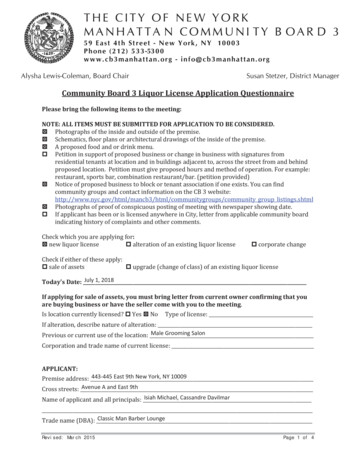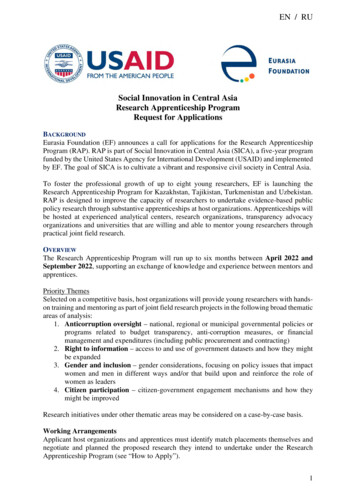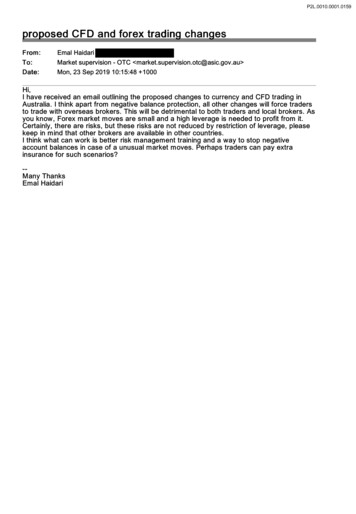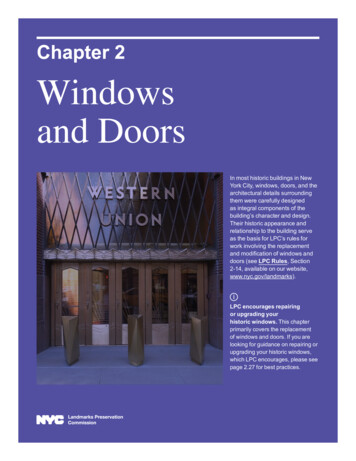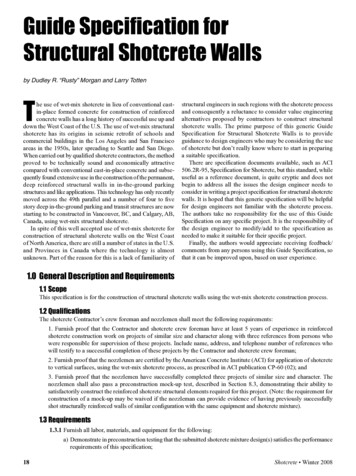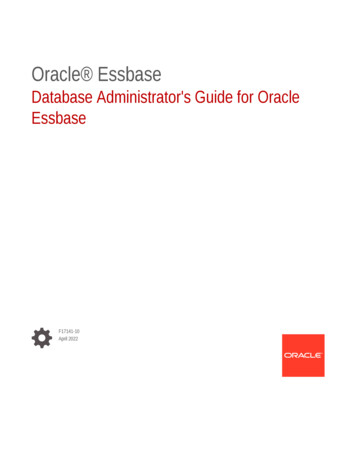
Transcription
Understanding The ProposedU.S. Risk Retention Regime Allen & Overy 2011The contents of this document are confidential
Allen & Overy LLP Understanding The Proposed U.S. Risk Retention Regime April 2011ContentsI. Executive Summary3II. What Types Of Transactions Are Covered?5III. Who Is Required To Hold The Retained Interest?6A. The Sponsor6B. Originator6C. Other Structures7D. Hedging, transfer and financing restrictions with respect to the retained interest7IV. Permissible Forms Of Risk Retention8A. Vertical Risk Retention8B. Horizontal Risk Retention8C. L-shaped Risk Retention8D. Representative Sample9E. Revolving Asset Master Trusts (Seller’s Interest)9F. Asset-Backed Commercial Paper Conduits9G. B-Piece Buyer of Commercial Mortgage-Backed Securities10H. Treatment of Mortgage-Backed Securities guaranteed by government-sponsored enterprises12I. Premium Capture Cash Reserve Account12V. Securitizations That Are Exempt From Risk Retention Or Subject To Reduced Risk Retention Requirements.14A. Qualified Residential Mortgages14B. Qualifying Commercial Real Estate Loans18C. Qualifying Automobile Loans19D. Qualifying Commercial Loans20E. Buy Back Requirements21VI. Exemptions For Certain Types Of Transactions22A. General Exemptions22B. Safe harbor for certain foreign-related transactions22C. Additional Exemptions23Risk Retention Initiatives Table24Annex29Key Contacts31 Allen & Overy 20112
Allen & Overy LLP Understanding The Proposed U.S. Risk Retention Regime April 2011I.Executive SummaryIn late March 2011, the Office of the Comptroller of the Currency, Department of the Treasury (OCC), the Board ofGovernors of the Federal Reserve System (Board), the Federal Deposit Insurance Corporation (FDIC), the Securities andExchange Commission (SEC), the Federal Housing Finance Agency (FHFA), and the Department of Housing and UrbanDevelopment (HUD) (collectively, the Agencies) approved and released a notice of proposed rulemaking (NPR) setting forthproposed rules to implement the requirements of Section 941(b) of the Dodd-Frank Wall Street Reform and ConsumerProtection Act (the Dodd-Frank Act). Section 941(b) was codified as new section 15G (Section 15G) of the SecuritiesExchange Act of 1934, as amended (the Exchange Act)1.The stated purpose of Section 15G is to provide securitizers with an incentive to monitor and ensure the credit quality of theassets underlying a securitization transaction, and align the interests of the securitizer with the interests of the investor. Themethod for achieving this stated purpose is the requirement that the securitizer holds at least 5% of the credit risk of eachsecuritized asset (with certain narrow exceptions) for the life of the securitization, which may not be directly or indirectlyhedged. The proposed risk retention rules would generally apply to all asset-backed securities (ABS), regardless of whetherthe offering is registered with the SEC, but it is proposed that certain foreign securitization transactions would benefit from asafe harbor.This retained risk can be held through one of several identified means: vertical slice; horizontal slice; L-shaped slice; and representative sample.In addition, it is proposed that certain other risk retention structures may be used in the context of specific types ofsecuritizations, such as: sponsors of revolving asset master trusts may satisfy their risk retention obligation by retaining a seller’s interest of at least5% of the total principal balance of the pool assets sharing the same risks as investors, on a proportionate basis; sponsors of commercial mortgage-backed securities may satisfy their risk retention obligation by selling a subordinatedinterest to a third party who agrees to retain such subordinated interest (a horizontal interest); and sponsors of asset-backed commercial paper (ABCP) conduits may satisfy their risk retention obligation if each originatorseller retains an eligible horizontal residual interest in each intermediate SPV established by or on behalf of that originatorseller for purposes of issuing interests to the eligible ABCP conduit.In addition, for interest-only securities and other ABS sold at a premium, the premium would essentially be converted intoadditional risk retention as a result of the new requirement that such premium be maintained in a premium capture cashreserve account.1We are happy to supply a comparison summary of U.S. and EU risk retention initiatives upon request. Our ABS Regulatory ReformRoadmap online service also provides practical guidance on key regulatory initiatives from a structured finance perspective, includinginformation on the corresponding cross-border considerations. We would be happy to provide access upon request. Allen & Overy 20113
Allen & Overy LLP Understanding The Proposed U.S. Risk Retention Regime April 2011Certain securitization transactions will be exempt from, or subject to reduced, risk retention obligations based on assetcategory, as described in Section V below. Other general exemptions to the risk retention obligations are described in SectionVI below.The NPR is open to public comment until June 10, 2011. The Dodd-Frank Act’s risk retention requirements will becomeeffective (i) one year after the proposed rule becomes effective with respect to mortgage-backed securities and (ii) two yearsafter the proposed rule becomes effective with respect to other ABS. The risk retention requirements, as proposed, would notapply retroactively to ABS issued prior to such date.22Although Dodd-Frank Act is silent as to the retroactive effect of Section 941, the NPR clarifies that Section 15G does not apply to ABSissued before the applicable effective date of the final rules. As a general matter of U.S. administrative law, regulation with retroactiveeffect requires express statutory authorization. See Bowen v. Georgetown Univ. Hosp., 488 U.S. 204, 208 (1988) (“A statutory grant oflegislative rulemaking authority will not, as a general matter, be understood to encompass the power to promulgate retroactive rules unlessthat power is conveyed by Congress in express terms.”); Rock of Ages Corp. v. Sec. of Labor, 170 F.3d 148, 158 (2d Cir. 1999). Allen & Overy 20114
Allen & Overy LLP Understanding The Proposed U.S. Risk Retention Regime April 2011II. What Types Of Transactions Are Covered?3Under the proposals, retention would be required in the context of a "securitization transaction". This term is defined as "atransaction involving the offer or sale of asset-backed securities by an issuing entity".An asset-backed security is defined in Section 3(a)(77) of the Exchange Act as:(A)a fixed-income or other security collateralized4 by any type of self-liquidating financial asset (including a loan, alease, a mortgage, or a secured or unsecured receivable) that allows the holder of the security to receive payments that dependprimarily on cash flow from the asset, including—(i)a collateralized mortgage obligation;(ii)a collateralized debt obligation;(iii)a collateralized bond obligation;(iv)a collateralized debt obligation of ABS;(v)a collateralized debt obligation of collateralized debt obligations; and(vi)a security that the SEC, by rule, determines to be an ABS for purposes of this Section; and(B)does not include a security issued by a finance subsidiary held by the parent company or a company controlled bythe parent company, if none of the securities issued by the finance subsidiary are held by an entity that is not controlled by theparent company.Synthetic securitizations are excluded.While the definition of ABS is very broad, the NPR states that “because the term 'asset-backed security' for purposes ofSection 15G includes only those securities that are collateralized by self-liquidating financial assets, 'synthetic' securitizationsare not within the scope of the proposed rules.”3The definition of ABS is so broad that it could be interpreted to include certain interests in hedge funds, warehouse structures, and otherfund structures that have not been considered asset-backed securities by the market in the past. However the definition would not apply toABS interests issued in the form of common or preferred stock, limited liability interests, partnership interests, trust certificates or similarinterests evidencing ownership of the issuing entity, and the resulting payments, if any, on which are not primarily dependent on the cashflows of the collateral held by the issuing entity.4Collateral, as defined under the proposed rules, means the assets or other property that provide the cash flow for the ABS interestsirrespective of the legal structure of issuance, including security interest in assets or other property of the issuing entity, fractional undividedproperty interest in the assets or other property of the issuing entity, and leases that convert to cash proceeds from the disposition of propertyunderlying the assets. Allen & Overy 20115
Allen & Overy LLP Understanding The Proposed U.S. Risk Retention Regime April 2011III. Who Is Required To Hold The Retained Interest?Section 15G requires the risk retention requirements be applied to the “securitizer” of ABS. The securitizer is defined as “(A)an issuer of an asset-backed security; or (B) a person who organizes and initiates an asset-backed securities transaction byselling or transferring assets, either directly or indirectly, including through an affiliate, to the issuer.” The NPR states that part(B) of the securitizer definition is the equivalent to the definition of “sponsor” under Regulation AB of the Securities Act of1933, as amended (the Securities Act). It should be noted, however, that the NPR is not limited to transactions that areregistered under the Securities Act and/or subject to the disclosure requirements set out in Regulation AB. The Agenciesfurther interpret “issuer of any asset-backed security” as referring to the “depositor” of the ABS.The proposed rules permit the transfer by the sponsor of its retained risk to one or more consolidated affiliates so long as suchaffiliates remain consolidated with the sponsor for accounting purposes.A.The SponsorA sponsor is a person who organizes and initiates an ABS transaction by selling or transferring assets, either directly orindirectly, including through an affiliate, to the issuer. If there are two or more entities meeting the definition of “sponsor” in asingle ABS transaction, then one of the sponsors is required to satisfy the risk retention requirements. Where there aremultiple sponsors, each sponsor remains responsible for ensuring that at least one sponsor complies with the requirement. Theproposed rules do not allow multiple sponsors to divide the risk retention obligation. In the CLO context, a collateral managerwho selects and manages the underlying assets would be considered a sponsor.B.OriginatorAn originator is the person who (i) through the extension of credit or otherwise, creates a financial asset that collateralizes anABS and (ii) sells an asset directly or indirectly to a securitizer.Subject to the conditions and restrictions discussed below, a sponsor may reduce its required risk retention obligations in asecuritization transaction by the portion of risk retention obligations assumed by the originator(s) of the securitized assets,provided that the conditions below are met.1.Each originator must be the originator of at least 20% of the underlying assets.2.The risk allocated to each originator must be at least 20%, but not more than the percentage of the underlying assetsoriginated by such originator.Additional requirements include:1.The originator will be held to the same requirements with respect to its retained interest as the related sponsor,including the limits on hedging discussed further in Section III.D below.2.The sponsor and the originator must use either the horizontal or vertical retention method, and both must use thesame risk retention method. Allen & Overy 20116
Allen & Overy LLP Understanding The Proposed U.S. Risk Retention Regime April 2011C.Other StructuresAs further discussed herein, different risk retention holding options are proposed to be made available for certain dealsincluding commercial mortgage-backed securities transactions and ABCP conduits. In addition, special rules apply withrespect to ABS issued at a premium.D. Hedging, transfer and financing restrictions with respect to theretained interestSection 15G requires the risk retention regulations to “prohibit a securitizer from directly or indirectly hedging or otherwisetransferring the credit risk that the securitizer is required to retain with respect to an asset.” As discussed above, a sponsor cantransfer its retained interest to a consolidated affiliate; this prohibition on hedging or transferring the retained interest is alsoproposed to apply to such affiliates (i.e. if a hedge is improper for the sponsor, no consolidated affiliate could enter into thathedge).5In particular, under the proposals, the sponsor and its consolidated affiliates are prohibited from purchasing or selling asecurity or other financial instrument, or entering into an agreement (including an insurance contract), derivative or otherposition, with any other person if:(i)payments on the security or other instrument are materially related to the credit risk of any interests that theretaining sponsor is required to retain with respect to a securitization transaction or one or more of the particularsecuritized assets that collateralize the asset-backed securities issued in the securitization transaction; and(ii)the security or other instrument in any way reduces or limits the financial exposure of the sponsor to thecredit risk of the interests that the sponsor was required to retain.Transactions that hedge risks relating to the ABS other than credit risk, such as overall market movements, interest rate risk orthe overall value of a broad category of ABS, are permitted.Further, the sponsor would be able to acquire hedges tied to an index such as ABX.HE, provided that:(i)any class of ABS interests in the issuing entity that were issued in connection with the securitizationtransaction in which the sponsor was required to retain an interest and that are included in the index represented nomore than 10% of the dollar-weighted average of all instruments included in the index; and(ii)all classes of ABS interests in all issuing entities that were issued in connection with any securitizationtransaction in which the sponsor was required to retain an interest and that are included in the index represent, in theaggregate, no more than 20% of the dollar-weighted average of all instruments included in the index.In addition, any credit hedging obtained by the issuer of the ABS cannot benefit the holder of the retained interest in a waythat limits the sponsor’s financial exposure with respect to the retained risk.5The prohibition on hedging the retained credit risk will have a broad-reaching effect. A consolidated affiliate may be prevented fromengaging in transactions that are wholly unrelated to a securitization, but would be viewed as prohibited hedging under this rule. Further,because synthetic securitizations are not covered by the NPR, presumably a sponsor could hedge 100% of its credit risk in the underlyingassets through a synthetic securitization, but neither it nor any consolidated affiliate could engage in a transaction that would be viewed ashedging its retained credit risk. Allen & Overy 20117
Allen & Overy LLP Understanding The Proposed U.S. Risk Retention Regime April 2011IV. Permissible Forms Of Risk RetentionAs noted above, the proposals refer to various risk retention holding options that a sponsor can use to satisfy the requirementthat it retains at least 5% of the par value of all ABS interests6 in the issuing entity issued as part of the securitizationtransaction,7 or, under certain circumstances, 5% of the unpaid principal balance of all assets held by the issuer. The sponsorwill be required to report the amount and type of risk retention with respect to each ABS transaction to investors, the SEC andthe sponsor’s appropriate Federal banking agency (if any).A.Vertical Risk RetentionA sponsor would satisfy its risk retention requirement by holding a 5% interest in each class of ABS interests (regardless ofwhether or not any such interest is certificated, and including any beneficial or residual interest, provided that the payment ofsuch interest depends on the cash flows from the underlying assets), measured in each case by par value (if any), fair value,and number of shares or units.B.Horizontal Risk RetentionA sponsor would satisfy its risk retention requirement by holding an "eligible horizontal residual interest" that provides thesponsor with first-loss exposure to all ABS interests equal to 5% of the par value of all ABS interests issued as part of thesecuritization transaction. In order to qualify, the residual interest must be allocated all losses on the securitized assets untilthe par value of the residual interest is reduced to zero, it must have the most subordinate claim with respect to payments ofinterest and principal, and, until all other ABS interests in the issuing entity have been paid in full, it is not permitted toreceive any principal payments other than its current proportionate share of scheduled principal payments. As an alternative toretaining an eligible horizontal residual interest, the sponsor may satisfy the horizontal risk retention option by funding a cashreserve account equal to 5% of the par value of all the ABS interests issued as part of the transaction. Such account must bearthe first loss on the securitized assets in the same manner as the residual interest and meet certain other requirements withrespect to the ability of the trustee (as holder of the account) to invest amounts held in the account and limiting thecircumstances in which amounts can be withdrawn from the account).8C.L-shaped Risk RetentionL-shaped risk retention combines the vertical and horizontal risk retention options. The sponsor would maintain 2.5% of avertical component (i.e. of each class of ABS interests) and 2.564% of a horizontal component (taking into account the parvalue of all ABS interests other than those required to be retained as part of the vertical component). Each component wouldfunction in the same manner, and be subject to the same requirements, as the vertical and horizontal risk retention holdingoptions described above.6ABS interests (1) include any type of interest or obligation issued by an issuing entity, whether or not in certificated form, including asecurity, obligation, beneficial interest or residual interest, payments on which are primarily dependent on the cash flows of the collateralowned or held by the issuing entity; and (2) excludes common or preferred stock, limited liability interests, partnership interests, trustcertificates, or similar interests that: (i) are issued primarily to evidence ownership of the issuing entity; and (ii) the resulting payments, ifany, which are not primarily dependent on the cash flows of the collateral held by the issuing entity.7It is unclear how a sponsor is required to calculate the par value of any derivative instrument.8Unfortunately, the proposed rules do not permit a sponsor to satisfy the horizontal risk retention requirements by retaining a combination ofa residual interest and a cash reserve account which together equals 5% of all ABS interests. Allen & Overy 20118
Allen & Overy LLP Understanding The Proposed U.S. Risk Retention Regime April 2011D.Representative SampleA sponsor may satisfy its risk retention requirement by retaining a randomly selected representative sample of assets that isequivalent in all material respects to the securitized assets. The retained assets must equal 5% of the “designated pool” (basedon the unpaid principal balance of all assets initially identified for inclusion in the pool). The representative sample and thesecuritized assets must come from the same “designated pool” (i.e. designated by the sponsor). The designated pool mustcontain 1,000 separate assets for securitization. The representative sample will equal 5/95ths (5.264%) of the aggregate unpaidprincipal balance of the securitized assets.The securitizer must use a random selection process to create the representative sample. The methodology for selection is notproposed, but once the representative sample is created, the sample must be tested to confirm that, for each materialcharacteristic of the assets, the mean of any quantitative characteristic, and the portion of any characteristic that is categoricalin nature of the sample of assets randomly selected from the designated pool are within a 95% two-tailed confidence intervalof the mean or proportion, respectively, of the same characteristic of all the assets in the designated pool.The sponsor will be required to maintain policies and procedures for (i) identifying and documenting the materialcharacteristics of the assets in the designated pool; (ii) selecting assets randomly from the designated pool for inclusion in therepresentative sample; (iii) testing the randomly selected sample of assets in the designated pool; (iv) maintaining, until allABS interests are paid in full, documentation that clearly identifies the assets included in the representative sample; and (v)prohibiting, until all ABS interests are paid in full, assets in the representative sample from being included in the designatedpool of any other securitization transaction. Further, the sponsor will be required to hire an independent public accountingfirm to confirm that such policies and procedures are being followed.E.Revolving Asset Master Trusts (Seller’s Interest)Solely with respect to securitizations of revolving lines of credit, such as credit card accounts and dealer floorplan loans, asponsor could satisfy the risk retention requirement by holding a seller’s interest in the master trust equal to 5% of theprincipal balance of all of the assets held by the issuing entity (the Seller’s Interest). However, other types of securitizationsstructured as master trusts, such as UK residential mortgage-backed master trusts and CLO master trusts, or other transactionsthat include reinvestment but whose underlying collateral does not consist of revolving lines of credit, would not beconsidered a “revolving asset master trust” for purposes of the NPR.F.Asset-Backed Commercial Paper ConduitsThis Section applies only to sponsors of ABCP conduits that issue short-term ABCP (having a maturity of nine months orless) collateralized by receivables or loans and supported by a liquidity facility that provides 100% liquidity coverage from aregulated institution. This risk retention option would not be available to entities or ABCP programs that operate as securitiesor arbitrage programs, such as SIVs.Single-seller and multi-seller ABCP conduits are typically structured such that an “originator-seller” will sell the eligible loansor receivables to an intermediate, bankruptcy-remote special purpose vehicle (SPV) established by the originator-seller. Thecredit risk of the receivables transferred to the intermediate SPV then typically is separated into two classes: (i) a seniorinterest and (ii) a residual interest retained by the originator-seller. Allen & Overy 20119
Allen & Overy LLP Understanding The Proposed U.S. Risk Retention Regime April 2011Subject to meeting certain requirements set out below, a sponsor of an ABCP securitization transaction would satisfy its baserisk retention requirement with respect to the issuance of ABCP by an eligible ABCP conduit if each originator-seller retainsan eligible horizontal residual interest in each intermediate SPV as described above. The eligible horizontal residual interestretained by the originator-seller must equal at least 5% of the par value of all the interests issued by the intermediate SPV.Accordingly, each originator-seller would be required to retain credit exposure to the receivables sold by that originator-sellerto support issuance of the ABCP.This risk retention option is available only if the sponsor (i) establishes the eligible ABCP conduit, (ii) approves eachoriginator-seller permitted to sell assets, directly or indirectly, to the eligible ABCP conduit, (iii) establishes criteria governingthe assets that the originator-seller is permitted to sell to the intermediate SPV, (iv) approves all interests in the intermediateSPV purchased by the eligible ABCP conduit, (v) administers the eligible ABCP conduit by, among other things, monitoringthe interests in any intermediate SPV acquired by the eligible ABCP conduit and the assets collateralizing those interests and(vi) maintains and adheres to policies and procedures for ensuring that the conditions for satisfying the risk retentionrequirements have been met.An eligible ABCP conduit must meet each of the following criteria:1.the issuing entity must be bankruptcy-remote or otherwise isolated for insolvency purposes from the sponsor and anyintermediate SPV;2.the ABS issued by an intermediate SPV to the issuing entity must be collateralized solely by assets originated by asingle originator-seller;3.all the interests issued by an intermediate SPV must be transferred to one or more ABCP conduits or retained by theoriginator-seller; and4.a regulated liquidity provider must have entered into a legally binding commitment to provide 100% liquiditycoverage (in the form of a lending facility, an asset purchase agreement, a repurchase agreement, or similar arrangement) to allthe ABCP issued by the issuing entity by lending to, or purchasing assets from, the issuing entity in the event that funds arerequired to repay maturing ABCP issued by the issuing entity.G.B-Piece Buyer of Commercial Mortgage-Backed SecuritiesA commercial real estate loan is a loan secured by a property with five or more single family units, or by nonfarm nonresidential real property, the primary source (50% or more) of repayment for which is expected to be derived from theproceeds of the sale, refinancing, or permanent financing of the property; or rental income associated with the property otherthan rental income derived from any affiliate of the borrower. A commercial real estate loan does not include a landdevelopment and construction loan (including one-to four-family residential or commercial construction loans); any other landloan; a loan to a real estate investment trust (REIT); or an unsecured loan to a developer.A sponsor of a commercial mortgage-backed security (CMBS) may satisfy its risk retention requirements if a third-partypurchaser (commonly referred to as a B-Piece Buyer) acquires an eligible horizontal residual interest provide certainconditions are satisfied. Allen & Overy 201110
Allen & Overy LLP Understanding The Proposed U.S. Risk Retention Regime April 2011The conditions are as follows:1.the B-Piece Buyer must retain the eligible horizontal residual interest in the securitization in the same form, amount,and manner as would be required of the sponsor under the horizontal risk retention option;2.at least 95% of the total unpaid principal balance of the securitized assets in the securitization transaction arecommercial real estate loans3.the B-Piece Buyer must pay for the first-loss subordinated interest in cash at the closing of the securitization withoutfinancing being provided, directly or indirectly, from any other person that is a party to the securitization transaction(including, but not limited to, the sponsor, depositor, or an unaffiliated servicer), other than a person that is a party solely byreason of being an investor;4.the B-Piece Buyer must perform a review of the credit risk of each asset in the pool prior to the sale of the ABS. Thisreview must include, at a minimum, a review of the underwriting standards, collateral, and expected cash flows of eachcommercial loan in the pool;5.the B-Piece Buyer may neither (i) be an affiliate of any other party to the securitization nor (ii) have any controlrights in the securitization (including, but not limited to, acting as servicer or special servicer) that are not collectively sharedby all the other investors in the securitization, except that the B-Piece Buyer may be affiliated with one or more originatorsoriginating less than 10% of the unpaid principal balance of the securitized assets and may act as, or be an affiliate of, aservicer for any of the assets if the underlying securitization transaction documents provide for the appointment of anoperating advisor, as further described below;6.a sponsor will be required to disclose to potential investors a reasonable time before the sale of ABS and, uponrequest, to the SEC and the sponsor’s appropriate Federal banking agency (if any) the name and form of organization of the BPiece Buyer, a description of the B-Piece Buyer’s experience in investing in CMBS, and any other information regarding theB-Piece Buyer or its retention of the eligible horizontal residual interest that is material to investors in light of thecircumstances of the particular securitization transaction;9 and7.any B-Piece Buyer acquiring an eligible horizontal residual interest under this option must comply with the hedging,transfer and other restrictions applicable to such interest under the proposed rules if the B-Piece Buyer was a sponsor who hadacquired the interest under the horizontal risk retention option.The proposed prohibition on the B-Piece Buyer having control rights related to servicing is intended by the Agencies toaddress the potential conflict of interest that could arise between the B-Piece Buyer and senior certificate holders. However, aB-Piece Buyer could act as servicer, subject to certain conditions, if the underlying securitization transaction documentsprovide for the appointment of an in
2 Although Dodd-Frank Act is silent as to the retroactive effect of Section 941, the NPR clarifies that Section 15G does not apply to ABS issued before the applicable effective date of the final rules. As a general matter of U.S. administrative law, regulation with retroactive effect requires express statutory authorization. See Bowen v.



